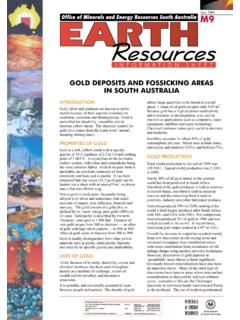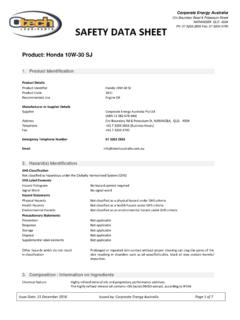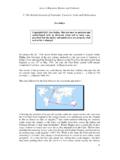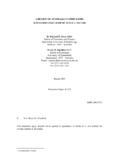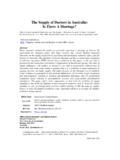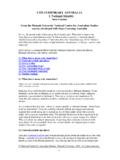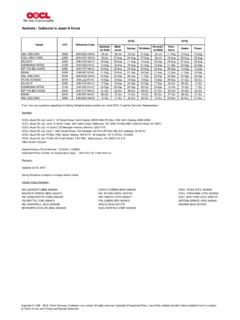Transcription of Farming Systems in Australia - jayasuriya
1 Farming Systems IN Australia . Rohan T. jayasuriya . CHARACTERISTICS OF THE REGION 3. MAJOR Farming Systems IN Australia 4. DRYLAND Farming system 6. PASTORAL Farming system 6. IRRIGATED AND DRYLAND MIXED Farming system 7. IRRIGATED RICE Farming system 7. IRRIGATED COTTON Farming system 8. IRRIGATED SUGARCANE Farming system 8. HORTICULTURE Farming system 9. DAIRY Farming system 10. POULTRY, SWINE AND GOAT Farming Systems 10. AQUACULTURE Farming system 11. FORESTRY Farming system 12. REGION-WIDE TRENDS IN Australia 12. POPULATION, FARM STRUCTURE AND INCOME GROWTH 12. NATURAL RESOURCES AND CLIMATE 13. SCIENCE AND TECHNOLOGY 15. TRADE LIBERALISATION AND MARKET DEVELOPMENT 16. POLICIES, INSTITUTIONS AND PUBLIC GOODS 16. INFORMATION AND HUMAN CAPITAL 18. SELECTION OF Farming Systems FOR ANALYSIS 19.
2 DRYLAND Farming system 19. CHARACTERISTICS OF THE system 19. TRENDS AND ISSUES IN DRYLAND Farming system 21. PRIORITIES FOR DRYLAND Farming system 21. IRRIGATED RICE, COTTON AND SUGARCANE Farming ( SEMI-INTENSIVE'). Systems 22. CHARACTERISTICS OF THE Systems 22. TRENDS AND ISSUES IN IRRIGATED RICE, COTTON AND SUGARCANE Farming Systems 24. PRIORITIES FOR IRRIGATED RICE, COTTON AND SUGARCANE Farming Systems 25.. Resource Management Economist, NSW Agriculture, 161 Kite Street, Orange 2800, Australia . Telephone: +61-2-63913343 Fax: +61-2-63913650 E-mail: The views expressed are those of the author, rather than those of NSW Agriculture or the NSW Government. 1. HORTICULTURE Farming system 26. CHARACTERISTICS OF THE system 26. TRENDS AND ISSUES IN HORTICULTURE Farming system 29. PRIORITIES FOR HORTICULTURE Farming system 29.
3 DAIRY Farming system 30. CHARACTERISTICS OF THE system 30. TRENDS AND ISSUES IN DAIRY Farming system 31. PRIORITIES FOR DAIRY Farming system 32. REFERENCES 32. 2. CHARACTERISTICS OF THE REGION. Australia , the smallest of the continents and the world's largest island is a compact land mass measuring approximately 3900 km from east to west at its widest point and about 3220. km from north to south. The total land area in Australia is 7,617,266 sq km (762 million ha). Native forest cover is estimated at 22% (164 million ha). Approximately one-third of the continent is classified as arid (receiving less than 250 mm average annual rainfall) and another third as semi-arid (250 to 500 mm). However, Australia 's northern, eastern, south- eastern and south-western areas with climates ranging from tropical to temperate and Mediterranean-style usually are well-watered, with regular rainfall.
4 These areas have become the main agricultural regions, although Australia also has developed techniques for Farming in drier areas. Total agricultural land is estimated to be 200 million hectares (approximately 25% is cultivated with equal areas on crops & sown pastures) out of which only 1% is irrigated though irrigation contributes 26% of the gross value of farm production (NLWRA, 2001). Irrigation has offered opportunities for agricultural intensification, greatly enhanced yields and the substitution of low value crops with higher value enterprises. Without irrigation, a significant proportion of Australia 's agricultural industries would either not exist or be greatly diminished. About two thirds of Australia 's agricultural production from irrigation is derived from the Murray-Darling Basin, producing rice, cotton, cereals, soybean, fruit and vegetable crops.
5 Outside the Basin, irrigation is used mainly for dairy pastures, seed, fodder, cereal, horticultural crops and sugar cane production. There were approximately 146,400 establishments engaged in agricultural activity that reported an estimated value1 of agricultural operations of $5,000 or more in the year 2000 (ABS, 2001). Australia has advanced in 200 years from a land without agriculture to one of the world's leading producers and exporters of food, natural fibres and livestock. This achievement has taken place in the face of harsh climatic and environmental conditions which necessitated the development of highly specialised agricultural Systems , skills and technology. Agriculture and food production is Australia 's largest and most diverse and most competitive industry. When the total chain from the farm and research laboratory to the processing plant, retail outlet and exporter is considered, it accounts for about 30% of the nation's total economic activity and directly/indirectly employs 20% of the Australian work force (National Farmers Federation, 1992 and 1998).
6 Australia 's gross value of farm production is $38 billion ( of GDP) with an export value of $ billion (forestry & fisheries an additional $2 billion each). Australia has a total population of million of which 381,000 ( national workforce) are employed in rural farm sector (forestry, fishing and hunting an additional 57,000) (ABARE, 2003). Today, Australia is the world's largest producer and exporter of wool; the largest exporter by quantity and the second largest by value of beef; and the third largest exporter of wheat. It is also the second biggest exporter of raw sugar to the open market and a significant overseas vendor of fruit and dairy products. Just over half of Australia 's exports go to nations in the developed world, principally Japan and the United States, a further one quarter are sought by the centrally planned economies while the remainder are purchased by developing countries.
7 The strongest growth in Australia 's export markets has in recent years been concentrated in these latter two groups (National Farmers Federation, 1998). The long term viability of the Australian agriculture depends on sustainable management practices and Systems , that is, those that are within the capability of the resource base to support. The effects of unsuitable agricultural practices are well documented. Experience 1. Unless otherwise indicated, the currency used is Australian dollars. 3. and research have assisted farmers in taking preventive and or remedial action to address many resource degradation problems. However, there is still a need for a better understanding of the relationships between natural resources and Farming Systems , which will facilitate improvements in sustainable agricultural practices.
8 MAJOR Farming Systems IN Australia . Eleven broad Farming Systems have been identified based on criteria discussed in Dixon et al, 2001. They are listed in the table below and the geographical distribution of eight of these Systems is indicated on a layout of agro-ecological regions in the accompanying map. Each Farming system is briefly described, followed by a discussion on region-wide trends. Finally, the main Systems are analysed in greater depth. Major Farming Systems in Australia Farming Systems Land Area / Farm Families / Enterprises % of Country People Employed Dryland 15% of the 33,200 families wheat, sorghum or country sunflower, wool, sheep meat, beef Pastoral 45% of the not available beef, sheep meat, wool country Irrigated and not available not available maize, sorghum, soybeans, Dryland Mixed canola, wheat, barley, oats, pastures, sheep and cattle Irrigated Rice 155,000 ha 2,000 families paddy rice, cereals, sheep Irrigated Cotton 459,300 ha 1,300 families cotton lint & seed, other crops, sheep, cattle grazing Irrigated 419,000 ha 6,900 growers sugar cane, raw sugar & by- Sugarcane 23,000 employed products molasses, bagasse & fibre Horticulture annual vegetables 93.
9 000 employed annual vegetables and & perennial fruit across 13,865 perennial citrus, nuts, pome 136,500 ha each properties fruit, stone fruit, tropical and wine grapes 4,500 wine grape fruit berry fruit, bananas, 128,000 ha growers wine and table grapes, cut flowers Dairy million ha 13,900 farms fresh milk and employ 50,000 manufactured dairy directly, another products 50,000 provide related services Poultry, Swine & not available poultry 1850 farms broiler meat, eggs, pig meat, Goat swine 3600 farms goat meat, milk & skin goat 2400 farms Aquaculture 95% production not available marine & freshwater finfish, in coastal waters crustaceans and shellfish Forestry commercially 14,000 growers & wood fibre (woodchip), & harvesters sawlog, sawnwood, million ha of 72,000 employed pulpwood native forest & in processing plantations 4.
10 5. Dryland Farming system Dryland Farming , also called rain-fed agriculture, is practised in regions where lack of moisture limits crop and/or pasture production to part of the year. This period is called the growing season and varies from a few months to about nine months in a normal' year. Rainfall is often low (250 to 500 mm) and variable but the more successful dryland Farming Systems have been established where rainfall (however low) is reliable and the start and finish of the growing season are fairly predictable. Successful Systems are not restricted to the wetter end of the spectrum. Dryland Farming Systems combine crops, pastures and fallow periods based on rotations for the fundamental purpose of making efficient use of the limited water. Dryland agriculture based on integrated livestock (sheep and cattle) and cropping farms is important in most mainland States of Australia .










